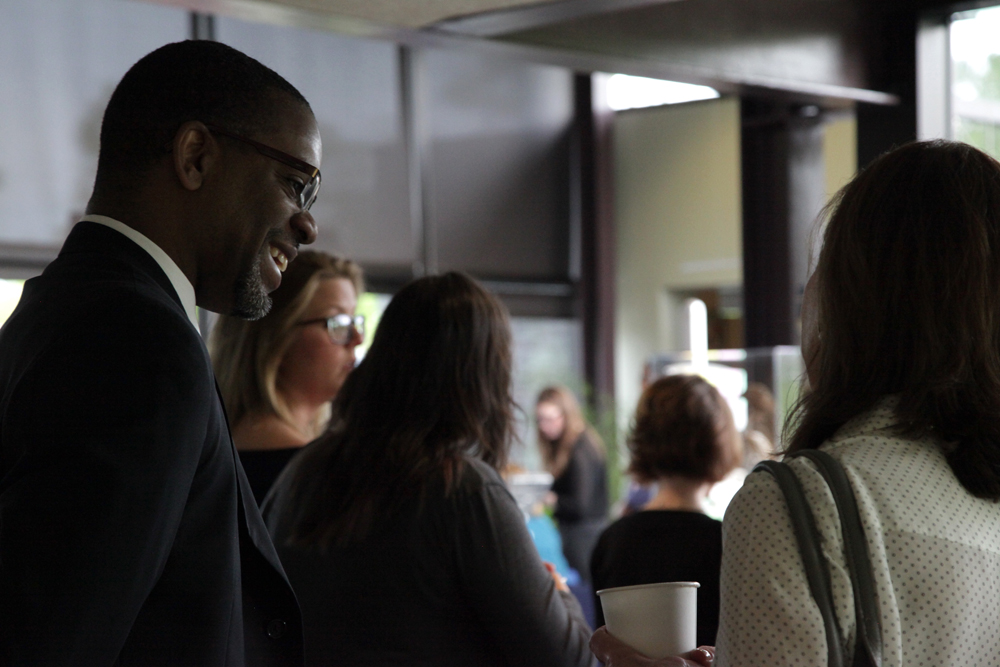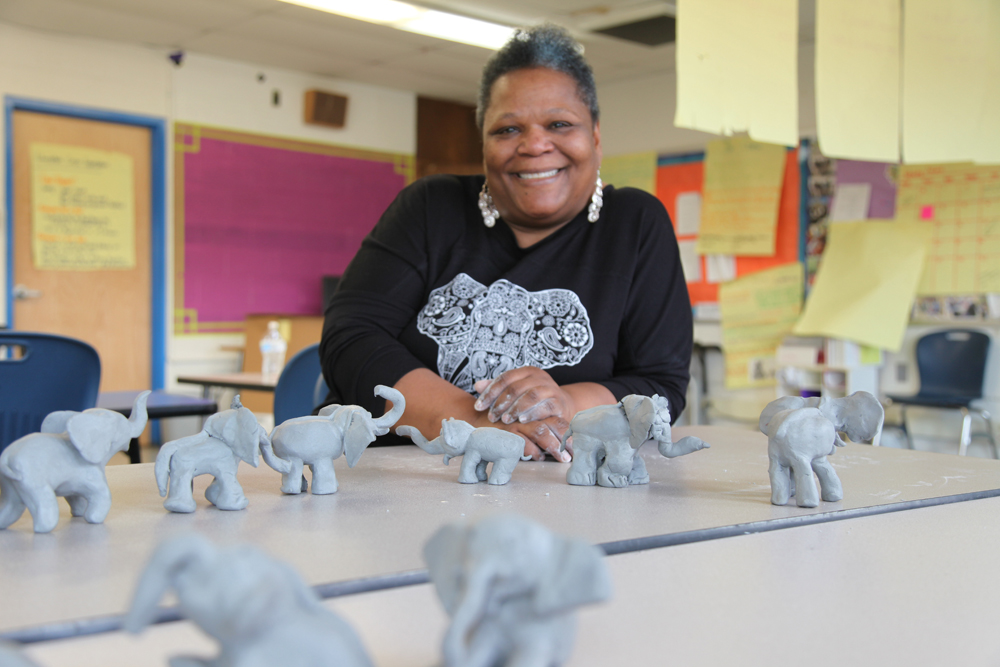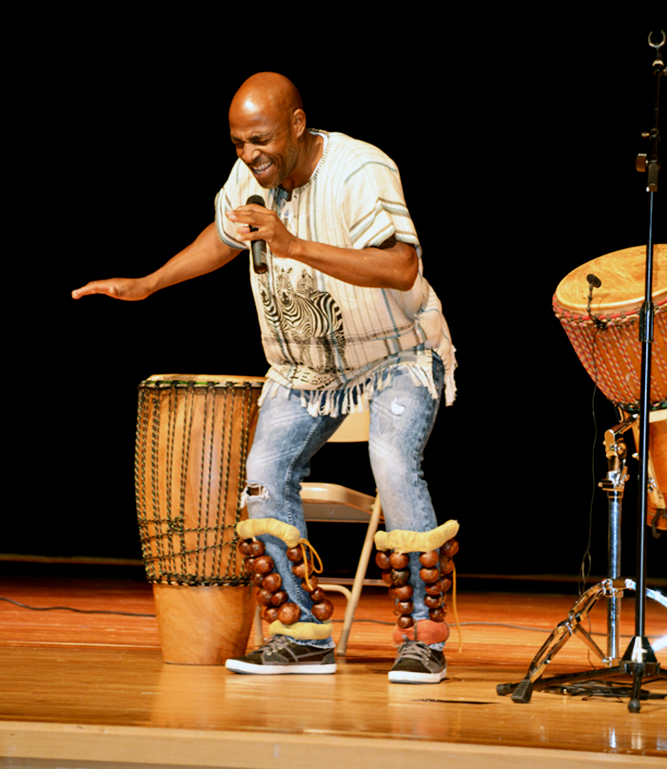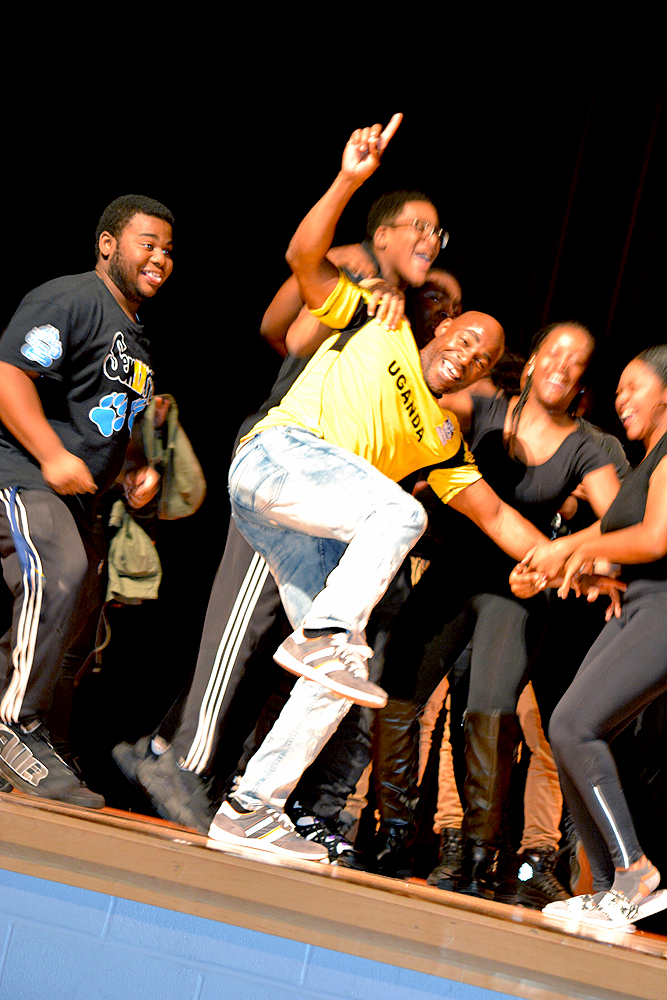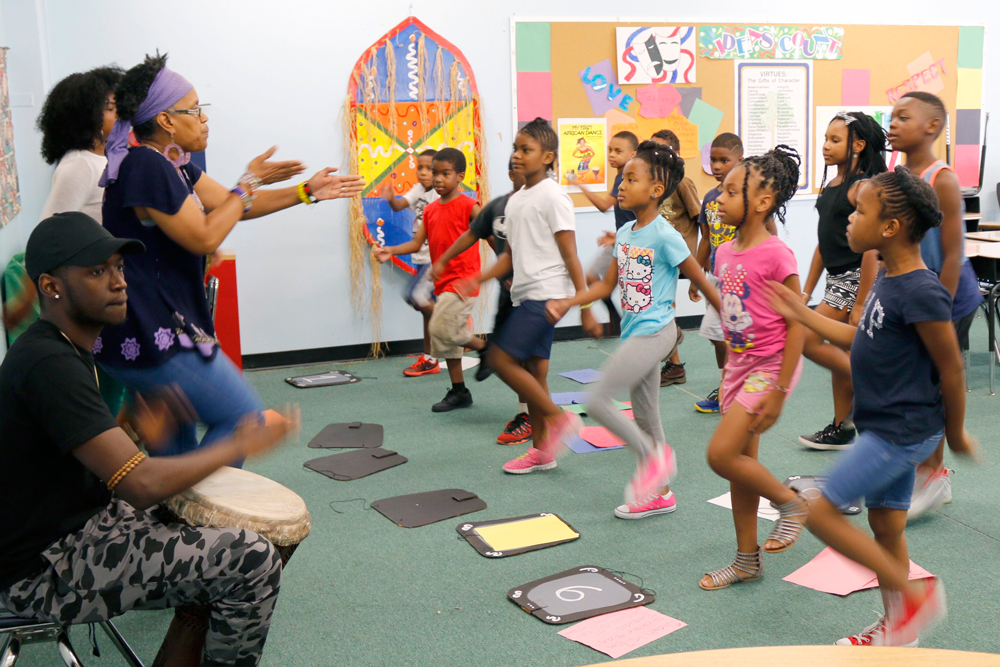Blog
Our Board of Directors: Bravely Creating Opportunities for our Students
We are reminded every day of the irreplaceable support we receive from those who share in our mission to transform the lives and education of Maryland students through arts experiences. From teachers and teaching artists to principals, parents, and donors, our list of allies is long. And because of our allies, the reach of our impact is wide and growing even wider.
“Thanks to our amazing staff and board, and to our supporters, including our Sunburst Society, our outreach has grown by 400%,” executive director, Stacie Sanders Evans, announced at the crowded Impact Breakfast last week. “Last year, we reached 191,000 students at nearly 500 schools with 225,000 hours of inspired learning! Also, we trained 1,096 teachers in arts-integrated instruction – so that means this kind of learning takes place even when our artists aren’t in schools.”
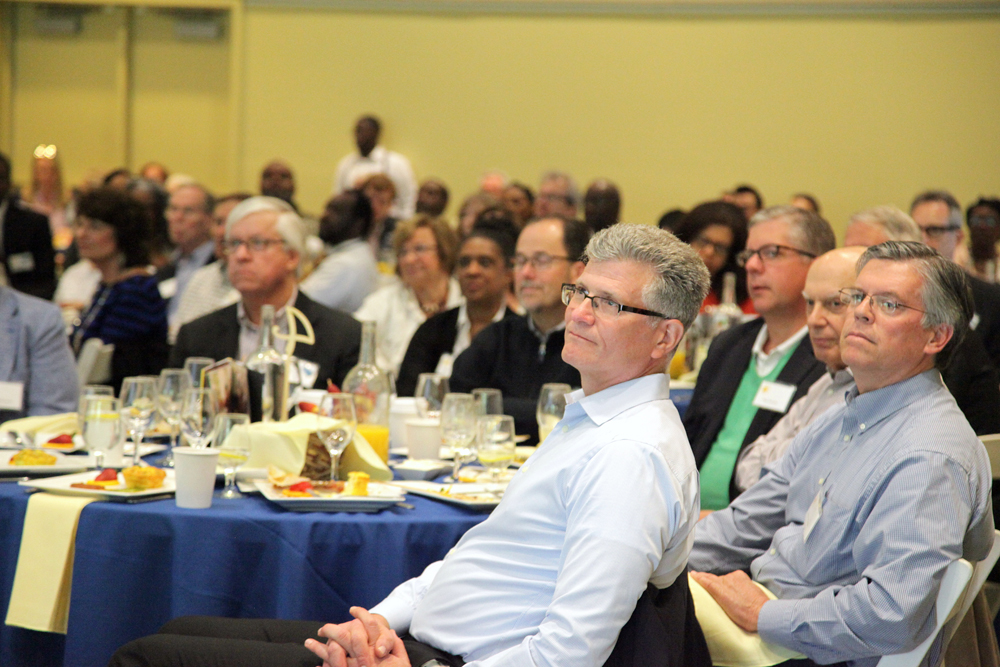

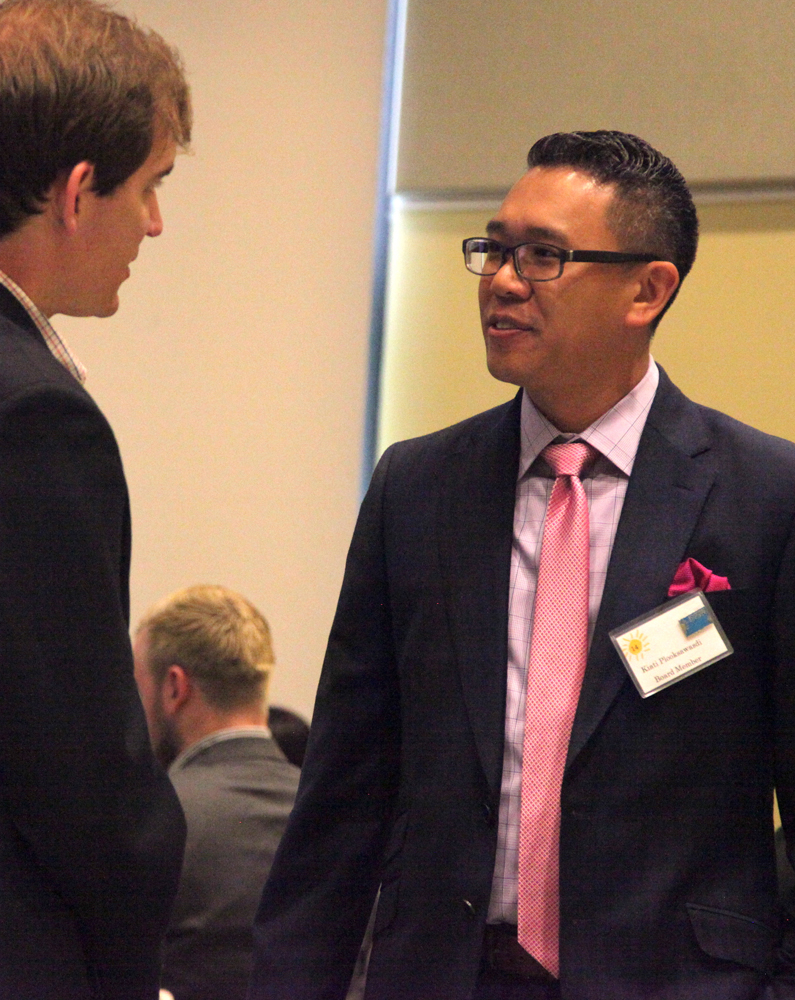
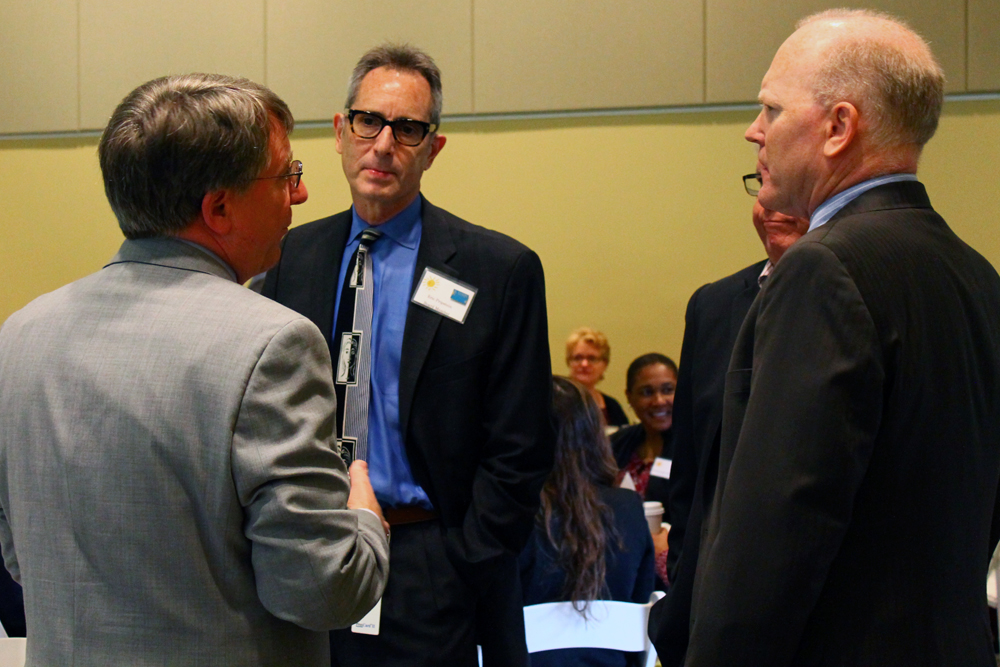
Our teaching artists live and breathe our mission through their work in classrooms every day. And that’s just the beginning. While they may fly under the radar, our board of directors includes 23 of the most engaged, hands-on leaders and supporters we could hope for. Their commitment is extraordinary. Our board members can be found supporting our work in any number of ways including authoring blog posts, hosting On The Brightside events or leading full-day staff and teaching artist trainings. You may find them meeting with potential sponsors over lunch, inviting colleagues to our events, learning dance routines with their co-workers from a teaching artist, or even volunteering to make sock-puppets at our Family Engagement Night!
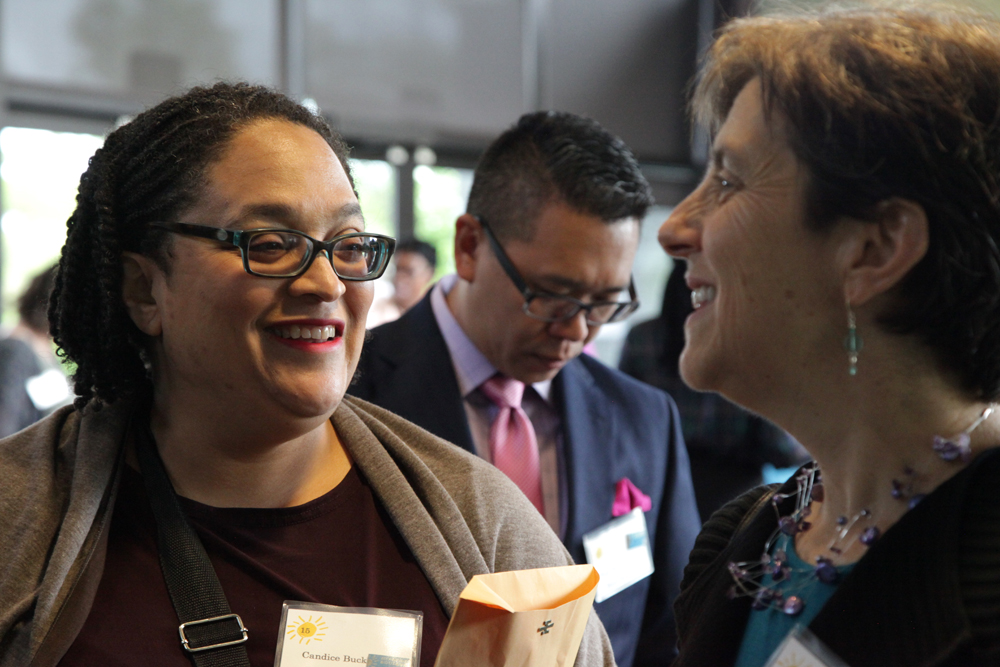
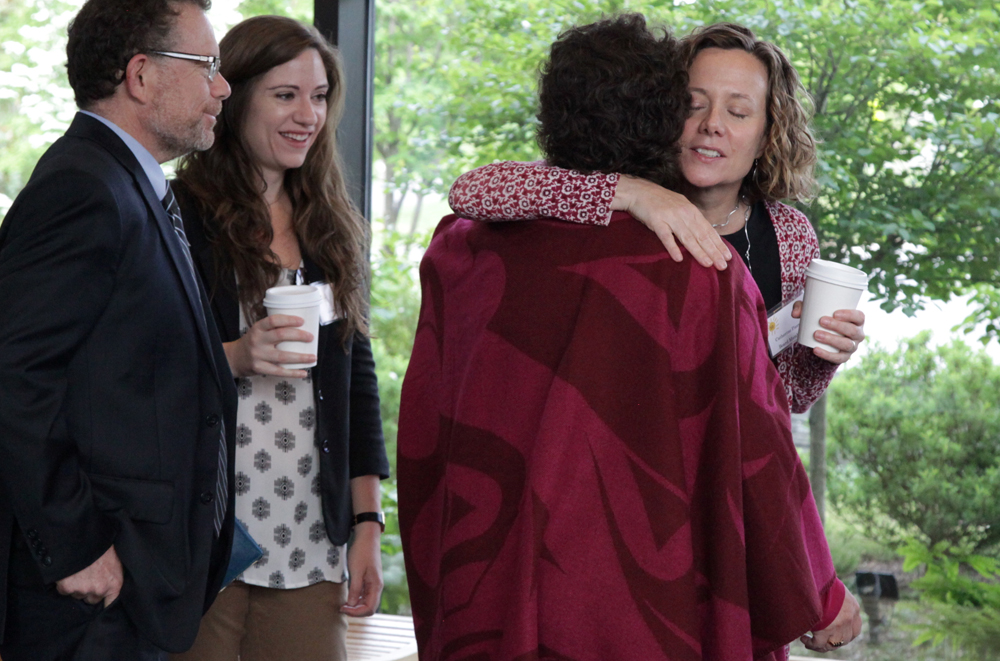
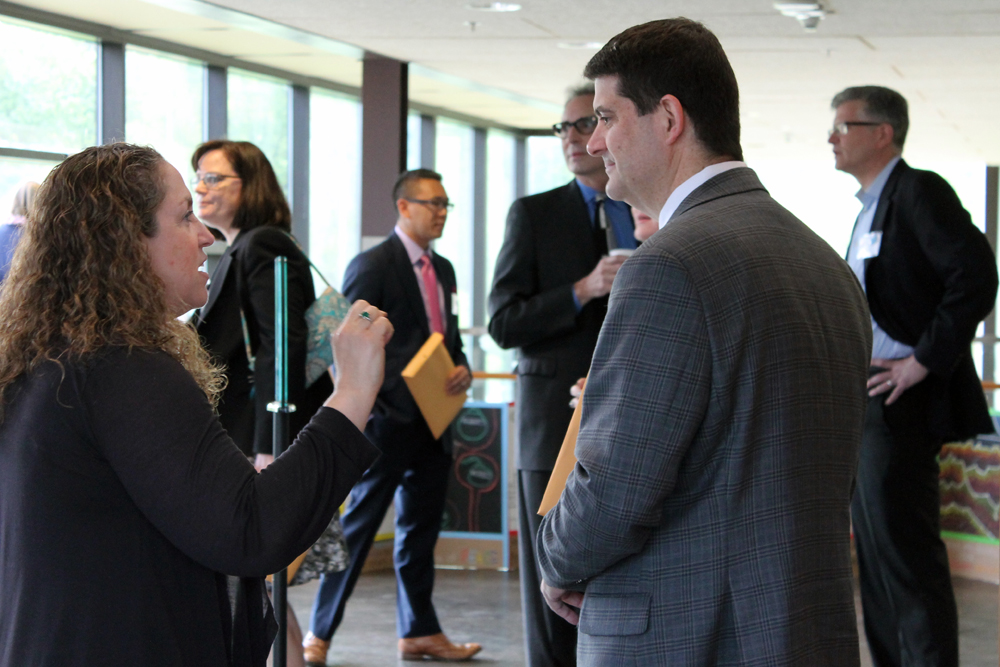
Our board members are proud of the work we all do and they are eager to say so. “Arts integration is when the arts are drilled down into an academic curriculum in a thoughtful and meaningful way – and that is what puts the ‘Arts for Learning’ in our name and what makes Young Audiences/Arts for Learning so exceptional,” explained board member Tea Carnell at the Impact Breakfast. “What do the arts bring to a curriculum? Creativity, joy, and expression are the obvious ones. Arts integration brings mastery, perseverance, insight, focus, understanding, reflection, and problem solving.”
It is this passion for arts integration and the desire to reach all children that drives each one of us at Young Audiences, but we wouldn’t be able to do the work we do, and we wouldn’t be able to reach the children we reach, without the unwavering support of our board members. “We are at this incredible moment in time. We have the evidence our programs work. We have a school system that is asking for help. All we need to do is bravely create the opportunities we know students need,” Stacie Sanders Evans told supporters. “Young Audiences, its incredible artists, everyone in this room – YOU – can close the gaps for our young people.”
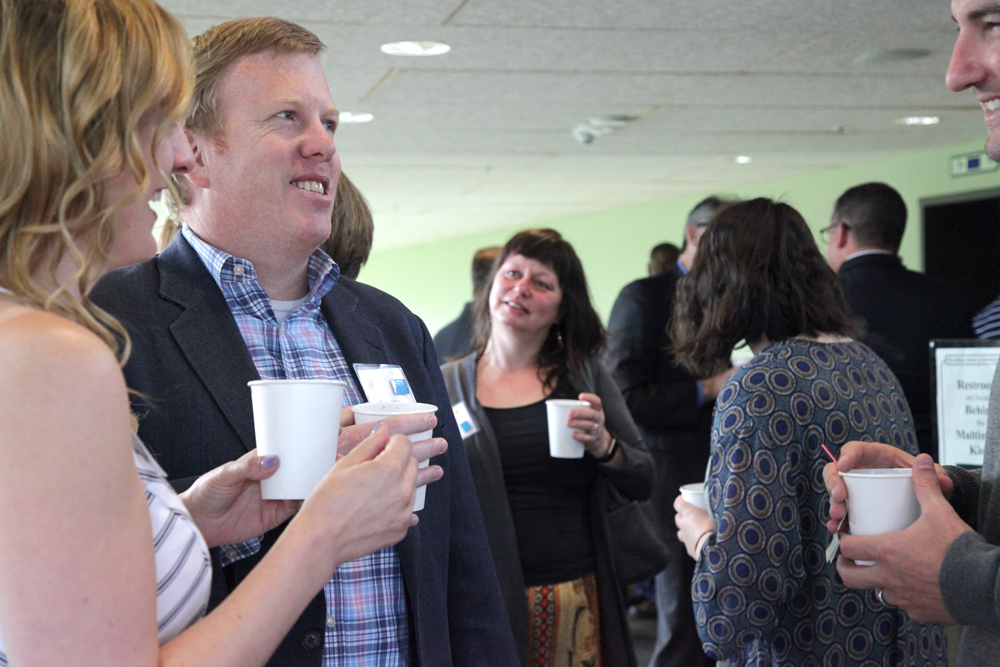
And you are. Because of you, we not only met, we surpassed our Impact Breakfast’s fundraising goal. From the bottom of our hearts, we extend a sincere thank you to our board, to Alan Hoff, chair of our major gifts committee, and to each and every one of our wonderful supporters. Visit yamd.org to learn more about the programs we offer and how you can help us reach even more children.
smARTbeats on the Radio

At Young Audiences, we are transforming the lives and education of young people through the arts by connecting educators, professional artists, and communities. Our roster artists use music, dance, visual arts, and theater to bring classroom lessons to life and empower students to think creatively and engage in the learning of all subjects in different ways. All of this contributes to joyful, creative, and impactful learning experiences in schools. Together, we are sparking imagination, energizing classrooms and giving children the tools they need to build, collaborate and thrive.

We are thrilled to announce a new partnership with WTMD to feature YA teaching artists on their new radio show Young At Heart, airing Saturday mornings! Beginning May 6, host Lisa Mathews—YA teaching artist and lead singer of Grammy-nominated children’s band Milkshake—will chat with YA roster musicians on a monthly segment called smARTbeats. Listeners will learn about the artists’ work, arts integration, and how the arts can reach students in the classroom.
“For me, songwriting with young people is STILL an exuberant experience – focused and playful, challenging and collaborative – and deeply satisfying for me.”
The series will begin with YA teaching artist and musician Sue Trainor. In the classroom, Sue teaches students to use songwriting as a tool to remember content. In the studio, her compositions are playful and fun – the kind of tunes that you can’t help but smile when you hear, with the kind of lyrics you won’t forget. “As a young person, I was captivated by the songwriting process. Musical jams with other kids were exuberant experiences,” Sue says, “For me, songwriting with young people is STILL an exuberant experience – focused and playful, challenging and collaborative – and deeply satisfying for me.”
“I’d like to think we’re at our best when we’re young at heart — when we have a youthful outlook on life no matter what our age,” host Lisa Mathews told WTMD. “I still like to ride the roller coaster, jump in rain puddles and eat toasted marshmallows. So listening to songs about taking a trip into space or the wonders of rainbows or eating lots of grapes rocks my world, and I hope it makes listeners smile while they start their day together.”
Young At Heart airs weekly from 7 to 8 am on Saturdays, featuring music that appeals to parents and children alike. Previous shows have featured music by Wilco, David Bowie, Andrew & Polly, Weezer, and others.
Hear YA teaching artist and songwriter Sue Trainor online now!
Growing Up Green at Mount Rainier Elementary School
Children in Prince George’s County Public Schools know how to celebrate Earth Day! Through Growing Up Green, a PGCPS arts integration initiative, children in kindergarten classrooms learn environmental stewardship by experiencing nature first-hand, marveling in the wonders of our natural world, and nurturing a passion within themselves to respect and preserve it. Funded in part by a BGE Green Grant and the Chesapeake Bay Trust, the program engages kindergarteners in meaningful and authentic outdoor experiences that help connect them to their local ecosystems and inspire them to learn more about protecting our environment. The arts provide the vehicle that the students use to demonstrate and communicate their understanding to the greater learning community of their school.

At Mount Rainier Elementary School recently, YA roster artist Pam Negrin worked with young students to record their own observations of plant life over the course of her residency, The Life Cycle of Plants. On outdoor adventures, the class immersed themselves in the drama of nature. They set out to identify and explore the many characteristics of plant life in all of its forms: seeds, seedlings, mature plants, flowers, and fruit. Their drawings and observations were then rendered in colorful yarn, stitch by stitch into one large-scale embroidered mural for their entire school community to learn from and enjoy.

The children’s work serves as a reminder of one of the biggest lessons even our smallest students can teach us. Just as this kindergarten class’ finished mural is a collaborative effort, so is making our world a safe, strong, and healthy one for every living being. Happy Earth Day to all.
Pam Negrin’s artwork includes embroidery, appliqué, drawing, collage, improvisational quilting, printmaking and sculpture. Her residencies transform classrooms into creative and collaborative handwork studios where students create something beautiful together. Schedule one of Pam’s residencies for your classroom.
Planning for Excellence at Baltimore Design School
Before there is art, there is planning- lots of planning. This is something that 7th graders at the Baltimore Design School know all too well. Without it, the mural that these students created under the guidance of YA roster artist Amanda Pellerin and art teacher Stephanie Cafaro would not be the magnificent work that it is.
The class began with brainstorming and list-making. “We asked the students, “What’s important to you?” Amanda Pellerin explained, “And we had different posters that asked, “What’s important to you at home? What’s important to you at school? What’s important to you in your city? What’s important to you in the world?”
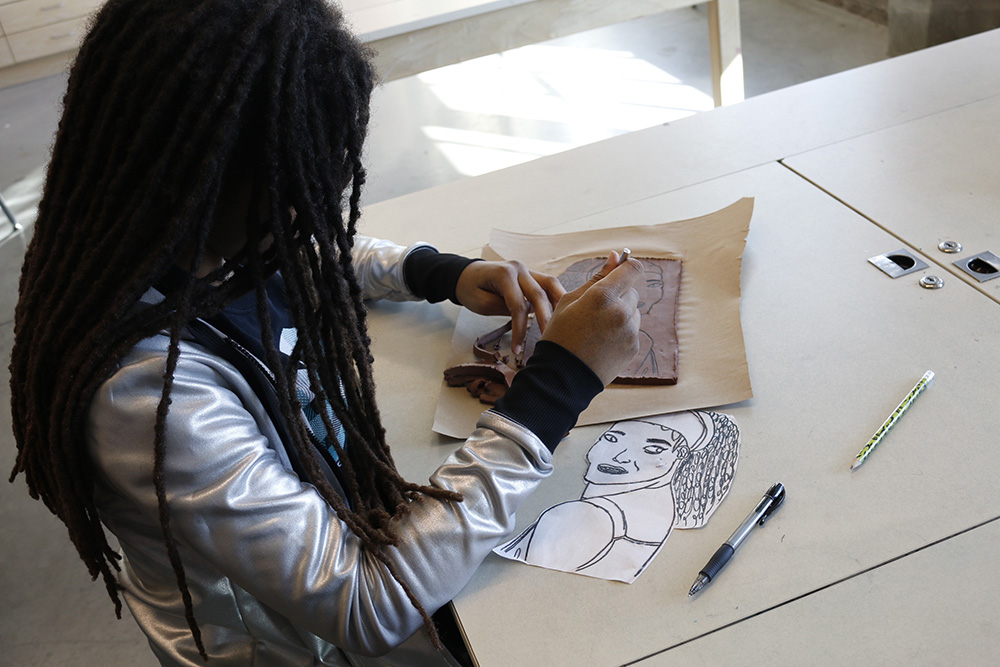
From these ideas, Miss Cafaro had the students narrow down what they believed to be most important into one list of possible mural themes. Some suggested a tribute to President Obama or a better Baltimore. Others wanted to illustrate the power of protesting or important issues in the world today. “When I looked at this, I didn’t see 10 different murals,” Pellerin said. So, the artist proposed combining each idea into one single, powerful mural, and the students were all for it.
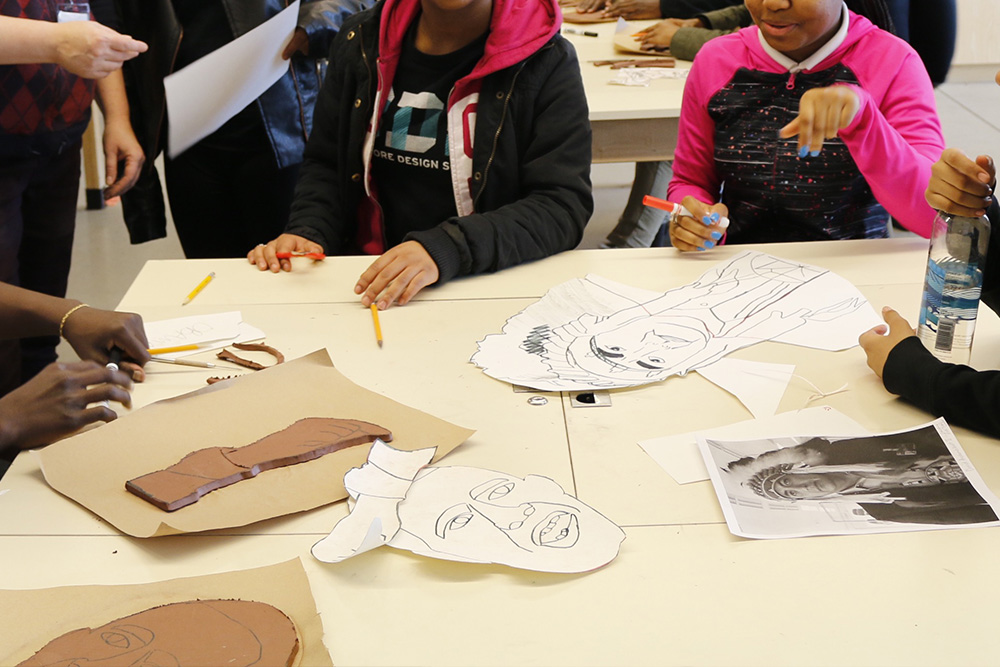
Before they could get to work on cutting and etching and glazing their tiles, however, the group first had to decide what the project was going to actually look like. After discussing composition and scale, and considering how the piece would flow visually, the group decided that the mural would feature three “larger than life” role models among a crowd of protesters. The class felt that President Obama, Harriet Tubman and a native American should stand out. The choices that the class made in the design process were purposeful. Role models weren’t chosen randomly, they were justified and carried significance for each student.

Small teams of students worked together to create each larger than life figure, then reunited to complete the picture and piece the mural together. In their finished artwork, historic role models protest alongside important figures of the present. The figures carry protest signs that reflect current issues with sentiments that students imagined each role model might express if given the chance today.
“We’re trying to help them understand that designers work as teams.“
From conception to execution, the class was instrumental in seeing the project to completion. Directing the vision of the finished piece allowed the students to take ownership of the artwork and truly see it as their project. “I love that they had to come up with a concept and work together,” noted Miss Cafaro. Every material that needed to be prepped and every decision that needed to be made happened because the class took charge, collaborated, and cooperated. “We’re trying to help them understand that designers work as teams,” Miss Cafaro said. “Even if it’s not their favorite idea, they’re part of a team and still need to contribute.”
Amanda Pellerin specializes in handmade tile murals and clay sculptures and has 20 years of experience in teaching both children and adults. Learn how to bring Amanda’s residency, Handmade Tile and Mosaic Murals, into your school.
The Power of TAI: Transforming Education Through the Arts
Teaching artists are expertly trained to deliver and coordinate unique, age-appropriate, and high-quality lessons alongside classroom teachers at the Teaching Artist Institute (TAI). The program is a partnership between Young Audiences, the Arts Education in Maryland Schools Alliance (AEMS), and the Maryland State Arts Council (MSAC) that turns professional artists into teaching artists and offers experienced teaching artists new strategies for everything from classroom management to designing artist-in-residence lessons.
“You might find yourself ‘shocked’ at how much electricity comes from the marriage of art and education!”
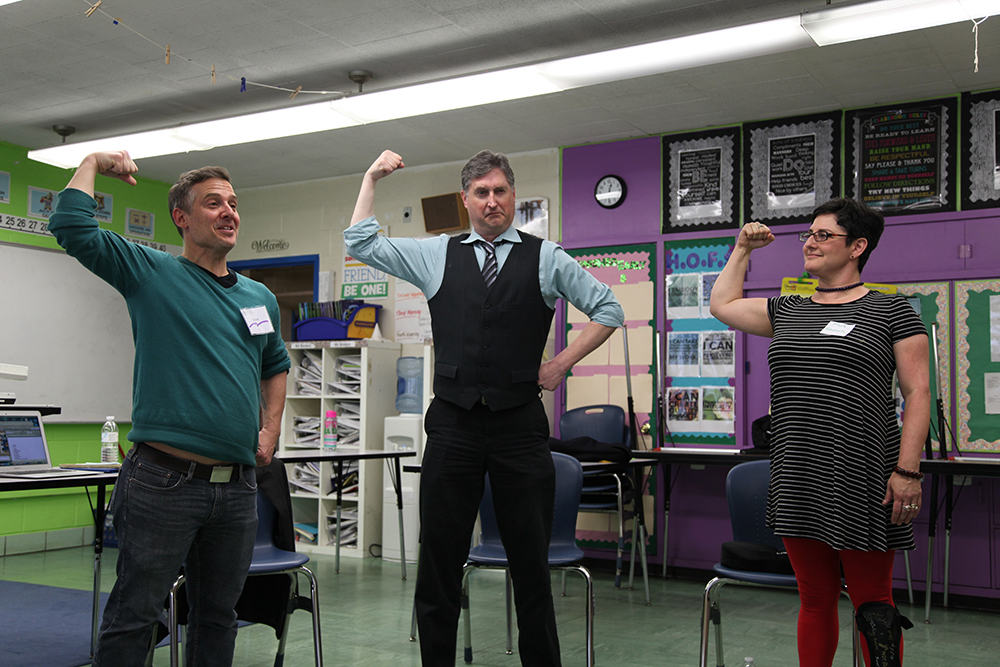
The positive effects of arts-integrated curricula in individual classrooms, and on teachers, students, and families are numerous and extraordinary. Teaching core subjects through the arts can increase student engagement and understanding. It can direct a classroom culture toward tolerance and empathy and it can even rejuvenate teachers and bring joy and anticipation to the faculty!
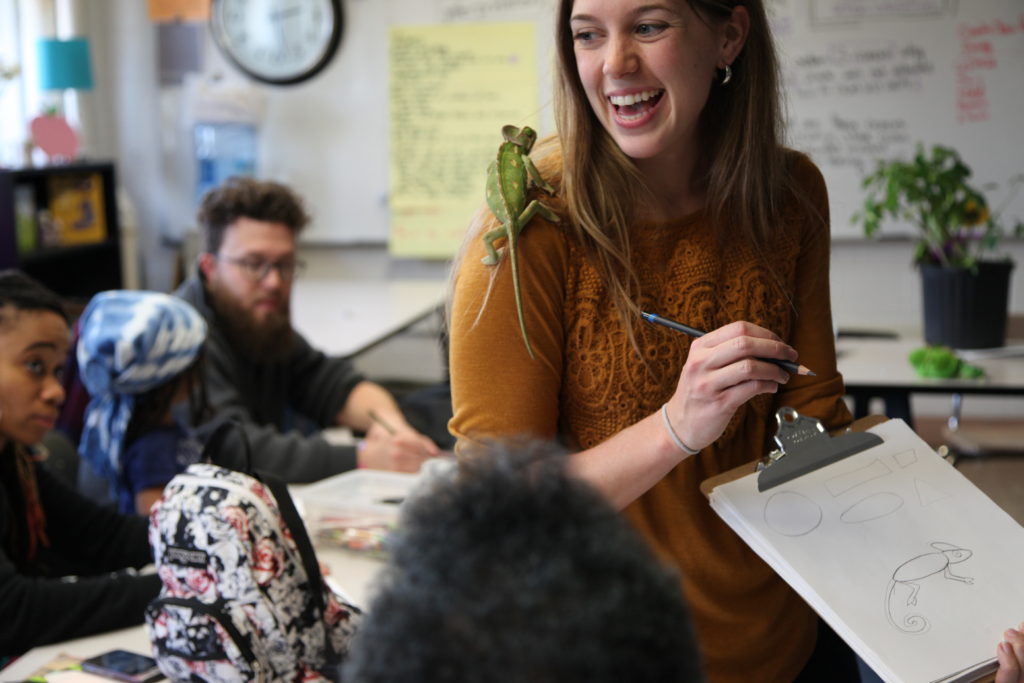
“Through its audacity, its abstractions, its “aliveness,” art activates parts of the brain that any teacher or employer should want to turn on,” notes Drew Anderson, a veteran school teacher and YA roster artist. “You might find yourself “shocked” at how much electricity comes from the marriage of art and education!”
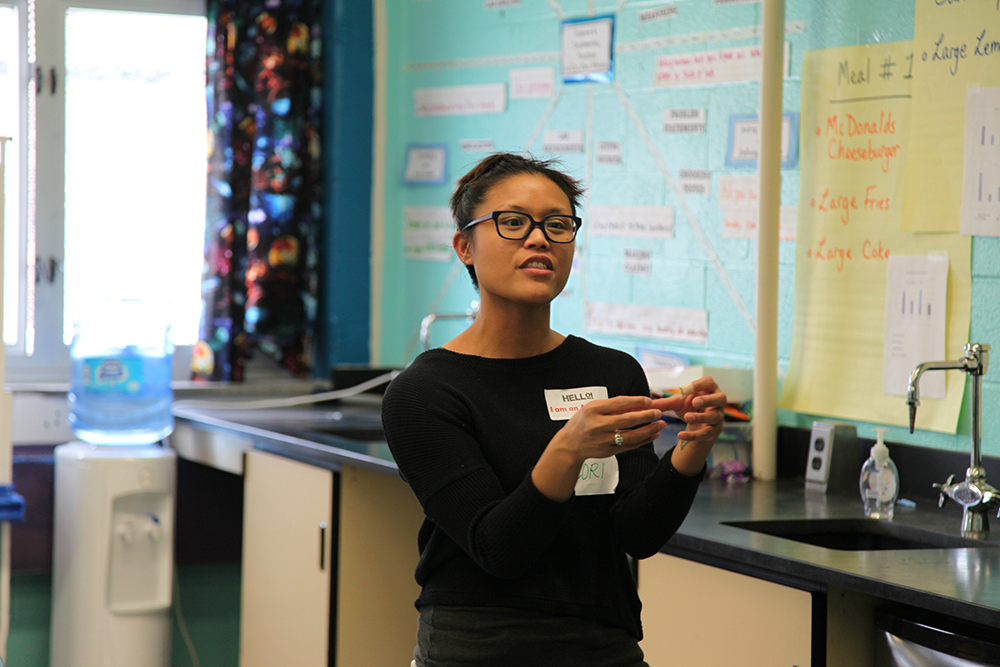
Teachers, families, and artists of all ages got a small taste of several teaching artists’ lessons during an afternoon at Southwest Baltimore Charter School. Participants spent their time exploring new skills and practicing old ones with: Performing artist and YA roster artist, Drew Anderson; Illustrator and new YA roster artist, Maura Dwyer; Illustrator, animal rescuer and new YA roster artist, Brittany Roger; Actor, Michael Hartwell; Actor, Tori Bertocci; Actor, Dave LaSalle; Actor, Cori Daniel; and Ceramicist and new YA roster artist, Mama Sallah.
They sculpted clay, interpreted music through movement and acting, sketched and learned about reptiles with a live chameleon, created collage utilizing different design elements, and learned awesome animal facts through improvisational theatre. One young participant was overheard telling her friend about Cori Daniel’s acting workshop, “It was so cool! We told stories with Ms. Cori without actually saying any words!” We can’t wait to hear about the wonderful classroom experiences and learning opportunities these teaching artists help to create!
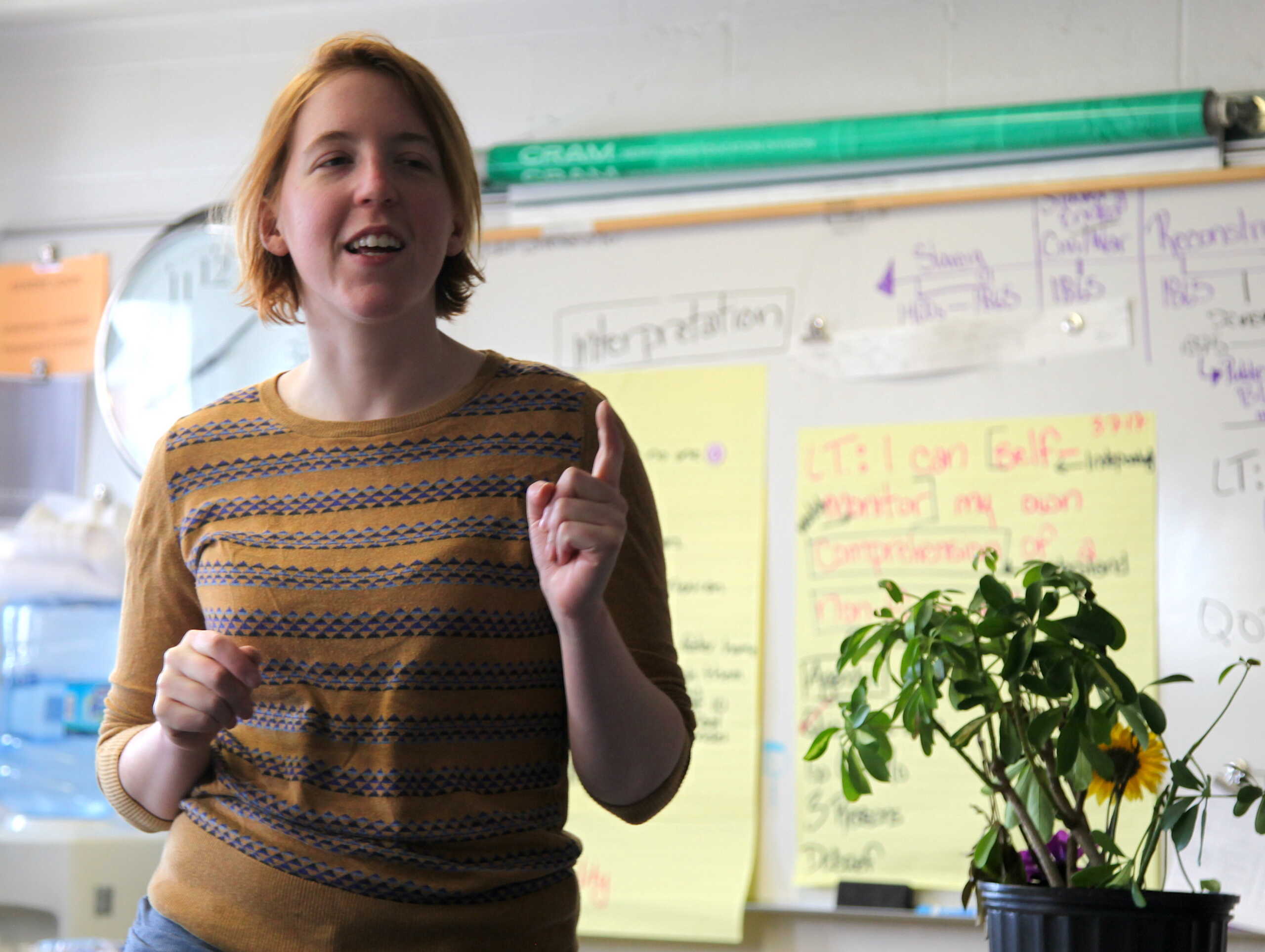
TAI is proud to be helping build a community of artists, teachers, and leaders who are committed to transforming education through the arts. Artists interested in designing lesson plans or teaching artist-in-residence programs should apply to this rigorous and renowned program. There are many things about TAI that make this professional development course unlike any other including mentorship from a designated teacher partner and from a master teaching artist in your art form. Not to mention, graduates of TAI have the opportunity to be considered for both the Maryland State Arts Council Artist in Residence Roster, and the Young Audiences/Arts for Learning Teaching Artist Roster!
For more information about the Teaching Artist Institute including videos, pricing and how to apply, click here. Read what artists are saying about the program on our testimonials page.
Maryland Wolf Trap Residency with Katherine Lyons
Unique and innovative arts-based strategies are captivating young audiences in Maryland classrooms. At Margaret Brent Elementary/Middle School in Baltimore City, the very youngest students are excited to connect to literature with actress and master teaching artist Katherine Lyons through movement and theater as part of a Maryland Wolf Trap residency.
Katherine creates what she describes as “hands-on, multi-sensory story experiences” by having children actively participate in the telling of the story. Physical motions are assigned to important objects and costumes help illustrate characters. To prepare for Katherine’s arrival on this day, Pre-K teacher Mrs. Lee asked her students to draw what they think will happen in the story. They hung one prediction on a clothesline.
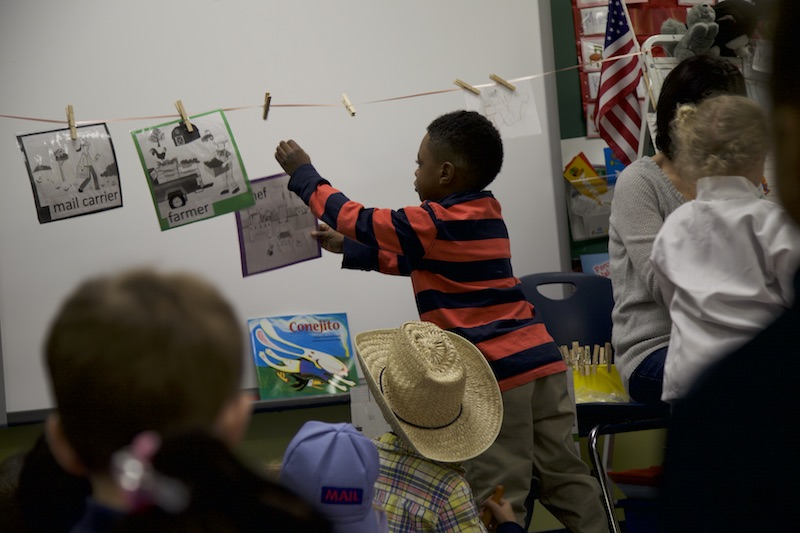
Now, at the front of the room, between Katherine and Mrs. Lee sits a ‘story box’ filled with clues describing the characters in the story. One by one, a student pulls from the box a tool or an article of clothing, then the class takes turns guessing who the clues belong to.
As each character is identified, one student hangs a picture representing the character on the clothesline and another student becomes the character. The students use each of their senses to connect to the story, made ever more lively through the introduction of gestures, chants, and props. “Costumes help bring the story to life,” Mrs. Lee said. “The class is more interested and invested in story time when they get to use props and act it out.”

Once story time is completed, Katherine and Mrs. Lee begin planning lessons that they will co-teach. Every Wolf Trap program includes embedded professional development to build teachers’ skills and confidence in arts integration techniques. Teaching artists work with classroom teachers to learn effective ways to engage students in participatory activities that involve all the senses and encourage critical thinking, creativity, communication, and collaboration. This ensures that the arts remain a strong part of the classroom teachers’ lessons long after the residency ends.

Mrs. Lee plans to continue to use these new strategies during an instruction block that includes literacy, social studies and science, but she’s excited to try them out in other areas of the curriculum as well. “I may use the story box with some counting stories and to help illustrate word problems in math!”
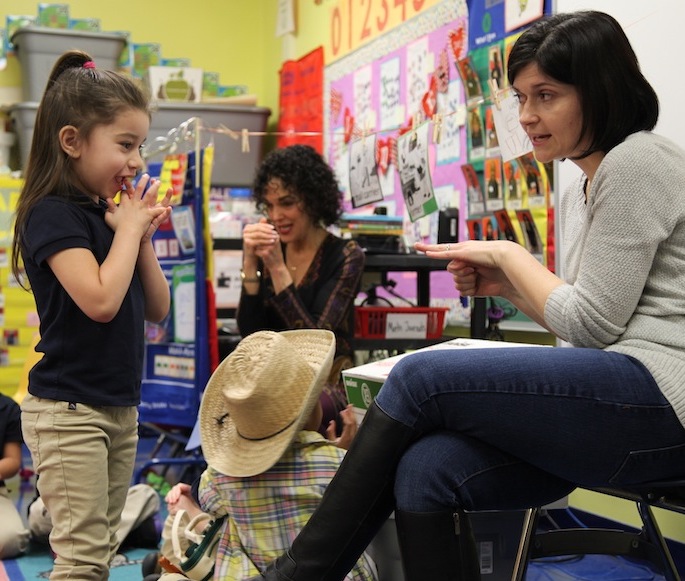
Eighty-five percent of brain development occurs during the first five years of a child’s life. Participation in the arts encourages positive growth in a child’s emotional, physical, intellectual, creative, and social development. As the Maryland affiliate of the Wolf Trap Institute for Early Learning Through the Arts, Young Audiences expands access to the arts for Maryland’s youngest students during the critical early learning years. Bring a Maryland Wolf Trap 16-Session Residency into your school.
Bloomberg Arts Internship: Designed to Challenge and Inspire
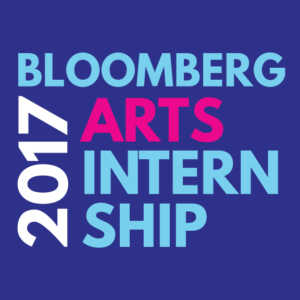 Young Audiences of Maryland and the Greater Baltimore Cultural Alliance are searching for 25 rising Baltimore City public high school seniors for a six-week paid summer internship!
Young Audiences of Maryland and the Greater Baltimore Cultural Alliance are searching for 25 rising Baltimore City public high school seniors for a six-week paid summer internship!
In 2012, Bloomberg Philanthropies created the Bloomberg Arts Internship program in New York City as a pipeline for public school students to college and careers. It is a rigorous program with three major elements: a six-week placement and project working day-to-day in an arts organization; visits to arts/cultural organizations; and professional development. This program’s success led the foundation to expand its reach, first to students in Philadelphia, and in 2017, to Baltimore City. Young Audiences and GBCA are thrilled to be able to offer this opportunity to Baltimore City School students as well as Baltimore’s arts and cultural institutions.
This is so much more than a summer job, it is a chance for young scholars to be challenged and inspired while getting meaningful, real-world experience. This phenomenal opportunity is made possible through the Bloomberg Arts Internship program which places qualified students at arts and cultural institutions across Baltimore City. This summer, 25 students will participate in a rich, immersive, and dynamic learning environment in which they will build career skills and plan for their futures. Baltimore’s renowned and reputable arts and cultural organizations will guide interns through both creative and administrative projects, offering a unique perspective of day-to-day operations within the art world.
STUDENTS
Interns are paid $9.25 per hour for 35 hours per week for the six-week internship, and an additional 20 hours during the orientation week—a total of 230 hours from June 20 – August 4, 2017. To apply, students must be enrolled in a Baltimore City public high school and:
- Successfully complete junior year in 2016-17
- Be 16 years of age or above by June 15, 2017
- Have a passion for the arts
- Commit to attend the 35-hour/week internship plus 20 hours of orientation (June 20-23)
- Commit to working full-time for 6 weeks from June 26-August 4
- Be able to work legally in the U.S.
Applications are due March 31, 2017
Submit an Application | Learn More
ARTS & CULTURAL ORGANIZATIONS
Arts and Cultural organizations play a critical role in The Bloomberg Arts Internship. We are looking for 12-15 partners with the capacity to provide a rich, quality experience for the interns and meet the necessary Bloomberg guidelines. Worksite partners will be paid $750 per intern to help offset the costs of staff time in supervising and guiding the intern(s). Although only 12 to 15 organizations will be selected as worksite partners, there will be other ways to collaborate with us on BAI, such as hosting visits as part of the cultural field trip days or participating as a presenter/panel member as part of the professional development curriculum.
The YA/GBCA team comprises members with expertise in arts leadership and management, curriculum development, and arts education. Partners can expect consistent support from the YA/GBCA staff throughout the program.
Applications are due April 14, 2017
Apply to Become a Worksite Partner | Learn More
For more information
contact Chaz Walters, Bloomberg Program Coordinator
[email protected] or call (855) 245-2787
“We are not going for noise, we are going for the core.”

Written by Tea Carnell, an active Young Audiences board member, Chair of 50,000 Kids Committee, and member of the Literature to Life Fundraising Committee.
Last fall, I was lucky enough to see Literature to Life’s staged presentation of Sue Monk Kidd’s The Secret Life of Bees in Washington, DC at a fundraiser hosted by Laura Handman, daughter of Literature to Life’s creator, Wynn Handman. Wynn Handman is also one of the founders of The American Place Theatre in New York City. That night, we were raising funds to bring this program to Prince George’s County Public Schools where it was performed last week.
I was moved by The Secret Life of Bees because, among other things, it touches on themes relevant not only to the students, but to everyone: racism and prejudice, the power of women, the vulnerability of women, what is real versus what is presented to us, and guilt and forgiveness. These issues are weighty and the performance compels the audience to confront them, showing that performance can exceed entertainment and that life’s biggest questions and broadest experiences can be captured and expressed. With the leadership of the teaching artist, Literature to Life creates an opportunity for students to consider and reflect. Wynn Handman once said, “There is so much noise in the entertainment world today, but where is the mind? We are not going for noise, we are going for the core. We do things that stay with youth, that get to them in a deep way…. That’s how we connect with youth. There is nowhere to hide from the story once the actor begins.” This opportunity is important for all students. And, it is especially critical for those students who don’t have access to the arts.
The performance of The Secret Life of Bees is accomplished just by one woman, Lily Balsen, playing all of the characters, and using verbatim excerpts from the novel. The actress spins these elements into a seamless production. I was lucky enough to see it again last week, on International Women’s Day. Of course, The Secret Life of Bees is a novel about women, and written by a woman. The date of the showing was a coincidence – a little serendipitous. Young Audiences/Arts for Learning was ‘showing off’ Literature to Life to a Baltimore-based audience interested in, and supportive of, arts in education.
This performance coalesced around the messages I had grown up with and personalized them for me with an immediacy that I had not yet experienced in the suburbs where I was growing up.
As I’ve thought about these wonderful performances, I have been reminded of the impact that a single play had on me as a child. I grew up just outside of Philadelphia in the mid-1970’s. In 1976, my parents took us to see One Acre at a Time at Freedom Theatre. Freedom Theatre is a Philadelphia-based theater company whose mission is “rooted in the African American tradition.” The play was intense, it made me uncomfortable, and the experience left me with lots to think about as a young person. During my childhood, my parents tried to educate me and my brother about the importance of the Civil Rights Movement. I always understood what they were telling me and accepted that racism and discrimination were wrong. I don’t remember the specific plot at this point. I do remember the impact of the emotion and passionate expression in the context of historical issues of race in the United States. This performance coalesced around the messages I had grown up with and personalized them for me with an immediacy that I had not yet experienced in the suburbs where I was growing up. That experience sits with me today and has left me with messages I don’t think could have been communicated in a more compelling way.
Literature to Life brought me back to that experience of being a child, moved profoundly and enduringly by a performance. I feel strongly about the power of theatre in the lives of students. Theatre has many layers for students beyond audience: content, expression, production. Children benefit from them all – as young writers, performers, writers, artists, stage crew.
4,000 young people will experience the staged presentation Secret Life of Bees and, afterward, participate in a “talk back” with Young Audience teaching artist Molly Moores and the phenomenal actress Lily Balsen, who travels from New York for these performances. The schools participating in the tour include:
Annapolis Road Academy
Bowie High School
Dr. Henry A. Wise, Jr. High School
International High School at Langley Park
International High School at Largo
Largo High School
Northwestern High School
Mount Washington School
Southwest Baltimore Charter School
I hope that Literature to Life will find its way to many more Maryland students. To learn more about the program, visit literaturetolife.org.
If you are like me and care about the power of theatre, or more broadly about the power of the arts in our schools, I suggest you get to know more about Young Audiences/Arts for Learning at one of its regular Bright Side events. Bright Side events are not fundraisers, rather they are one-hour, fun, interactive presentations that go more in-depth about our work (including all of our programs beyond theatre with music, visual arts, and dance) and share stories of the people we serve. The next event will be on March 21st at 5:30 pm at Herman, Sessa & Dorsey in Hunt Valley (307 International Circle Suite 280, Hunt Valley, MD 21030). To RSVP for this event, please email Chaz Walters at [email protected].

A Sense of Belonging: Ssuuna at Dr. Henry A. Wise, Jr. High School
Young Audiences teaching artist Ssuuna, a dancer, musician, and storyteller from Uganda, brought his incredible stage presence to Dr. Henry A. Wise, Jr. High School recently. There, he taught over 100 high school students African dance and drumming using the same focused energy and passion he delivers on stage. What struck the teachers in attendance, however, was how well Ssuuna guided his students in building a community and how expertly he handled distractions in the classroom, even with pointed interruptions.
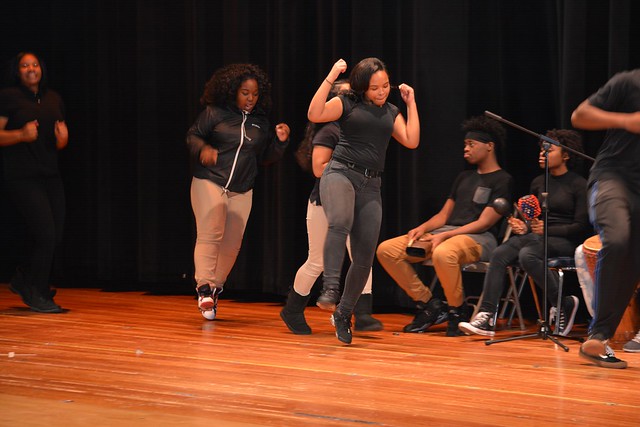
“He never raised his voice with them, but made it clear that their choices would have consequences,” recognized Mrs. Black, a 9th-grade teacher at the school. By encouraging students to examine each of his or her options and the consequences and rewards that go along with them, Ssuuna cultivates classrooms built on cooperation and encouragement. “He put the responsibility on the students to take ownership of their actions and choices, and it was very meaningful for students to have that responsibility.”
Another participating teacher, Mr. Hughes, observed that the residency made students feel more relevant. “Ssuuna met the students where they were and gave them confidence and a sense of belonging, no matter what their interest,” he said. This “relevancy” seemed to be felt not only internally, but collectively. Participants created their own inclusive ritual by uniting and forming a prayer circle before performing at the culminating dance. Mrs. Black recalled how powerful the moment felt to her, “I was really inspired to see all kinds of students coming together to be supportive and work as a team in that way.”
It is so important for students to be understanding, especially at this age, rather than making others feel like they don’t fit in.
The culminating dance introduced one last challenge when a student suffered a panic attack onstage. Ssuuna stepped in to join the student and spoke with her. In the moments that followed, she was able to regain control, breathing and finally relaxing. Teachers could actually see the transition from panic to calm occur within the student. Mrs. Black described the experience as transcendent for the teachers, the students, and the audience. “That moment made the whole experience feel more intimate, supportive, and vulnerable,” Mrs. Black explained. By witnessing first-hand Ssuuna’s kindness and encouragement with the student in distress, the audience was inspired to also be encouraging and supportive. “It is so important for students to be understanding, especially at this age, rather than making others feel like they don’t fit in.”
Honoring Black Women in Science
At the oldest public all-girls high school in the United States, students recently had the opportunity to work with fiber artist Pam Negrin to stitch the likenesses of important, black, female scientists onto one collaborative work of art. Along with partner teacher Jennifer Becker, and with help from both the science and graphic design departments, Pam worked with Western High School students on the large project from conception to realization.
“Many of these women truly were ‘hidden figures’ and one of the scientists, Stephanie Hill, was a Western alumna!”
 Drawing inspiration from the New York Times best-selling book, Women in Science, the group of students and teachers approached the project with reverence. “We lovingly call it our ‘Women in Science Mural’,” Mrs. Becker says of the artwork depicting portraits of women who paved the way for her students. “Many of these women truly were ‘hidden figures’ and one of the scientists, Stephanie Hill, is a Western alumna!”
Drawing inspiration from the New York Times best-selling book, Women in Science, the group of students and teachers approached the project with reverence. “We lovingly call it our ‘Women in Science Mural’,” Mrs. Becker says of the artwork depicting portraits of women who paved the way for her students. “Many of these women truly were ‘hidden figures’ and one of the scientists, Stephanie Hill, is a Western alumna!”
Three different classes participated in this exciting project. “First, Western’s lead science teacher, Ms. Washington, came up with a list of 25 women who have made important contributions in STEM fields,” Mrs. Becker explained. “Graphic design students were tasked to research each of the 25 scientists, then collaborated with another group of students in a fine art class to turn these women into beautiful embroidered portraits.”
 Pam taught the students how to project drawings onto fabric to create their own patterns. They learned various embroidery stitches to create different textures for hair, clothes, skin, and even a stitch for teeth! “Pam Negrin’s residency was the highlight of our year. The students are eager to see their finished artwork on permanent display in the Science department.”
Pam taught the students how to project drawings onto fabric to create their own patterns. They learned various embroidery stitches to create different textures for hair, clothes, skin, and even a stitch for teeth! “Pam Negrin’s residency was the highlight of our year. The students are eager to see their finished artwork on permanent display in the Science department.”

Pam Negrin’s artwork includes embroidery, appliqué, drawing, collage, improvisational quilting, printmaking and sculpture. Her residencies transform classrooms into creative and collaborative handwork studios where students create something beautiful together. Schedule one of Pam’s residencies for your classroom.
Celebrate Black History Month Through the Arts
With Black History Month upon us, we celebrate the contributions, activism, culture, and experience of African Americans. Many of our artists at Young Audiences have designed performances and assemblies to connect students with African American history and develop an in-depth understanding of the unique stories, struggles, and accomplishments of the past and the present. The following are just a few of the many talented artists available to bring a meaningful connection to African American history into your school.
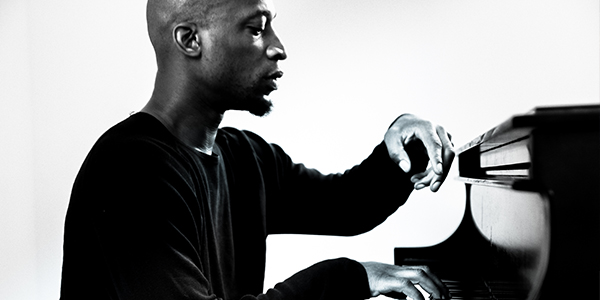
Kevin Gift introduces renown jazz pianists from Thelonius Monk and Art Tatum to Keith Jarrett in his assembly, Jazz Piano Masters. Students learn not only about the important contributions these musicians made to American music, but they also experience how improvisation can make practicing anything more enjoyable and personally satisfying.

Debra Mims has been an actress for over thirty years and was an arts producer at PBS for fourteen years. With additional training in dance, she received a BFA in Theatre Performance from Marygrove College in Detroit, Michigan. She has performed at the Georgetown Theatre Company, the Children’s Theatre in Madison, Wisconsin, and the Detroit-Windsor Dance Company.
In My Grandmother Told Me: A Tribute to African-American Women, Debra uses monologues, poetry, and song to tell tales of days past and of courageous Black women and their struggles to be free, to vote, and to get an education.
Professional spoken word artist and slam poet Femi the DriFish uses his artistry to encourage his listeners to discover their own unique voices and identities in his writings, performances, and teachings. His poetry performance, Write On, Then Say Word! is a spoken word/slam poetry journey through the various reasons to write and perform. Throughout the assembly, Femi shows students that they can draw subject matter for poetry from their identity and history.
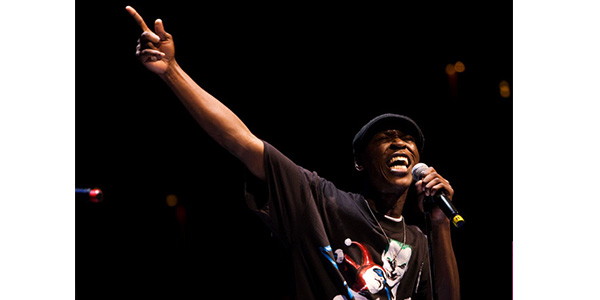

Schedule artists and programming to celebrate Black History Month by visiting our website.
Young Audiences Summer Arts Programming Improves Academic Performance
Baltimore students in Young Audiences Summer & Learning Arts Academy Outperform Peers
Baltimore City Public Schools students who participated in a new arts-related summer academic program from Young Audiences avoided summer learning loss and, in many cases, gained ground on their national peers in standardized testing, according to evaluations released Tuesday. The new findings showed potentially groundbreaking progress in tackling summer learning loss, a chronic challenge facing public schools.
The results, confirmed in two separate studies involving nearly 800 students, are significant because summer learning loss – particularly among students at or below poverty level – is among the most difficult challenges facing the Baltimore school district and other high-poverty schools across the country. During summer, students typically fall below where they ended the previous grade, setting them back as they start a new school year. In fact, a 2013 National Summer Learning Association (NSLA) survey of 500 teachers found that 66 percent reported the need to spend three to four weeks re-teaching students course material at the beginning of the year. Another 24% reported the need to spend five to six weeks doing the same.
“City Schools has enjoyed a great partnership with Young Audiences, not only during the school year but also the past two summers,” said Dr. Sonja Brookins Santelises, chief executive officer of Baltimore City Public Schools (City Schools). “During the summer, Young Audiences reinforces key math and reading concepts through the arts and creative activities – and we’re pleased with the results we’ve seen. When students participate in summer learning programs that help them move ahead or reduce learning loss, they start the school year off stronger.”
The Young Audiences Summer Arts & Learning Academy (SALA), run by the Baltimore-based arts-in-education nonprofit Young Audiences of Maryland in partnership with City Schools, was free for students and held at four sites across the city: Gardenville Elementary, Thomas Jefferson Elementary/Middle, William Pinderhughes Elementary, and Fort Worthington Elementary/Middle. Eighty-eight percent of the participating students were from high-poverty Title I schools.
“These results were a pleasant surprise given that we generally expect that students will lose ground over the summer,” commented Dr. Marc L. Stein, Associate Professor at the Johns Hopkins University School of Education, who conducted a separate program evaluation for Young Audiences which looked at participating students’ academic skill and social-emotional development. “The Young Audiences summer program combines many of the best practices of summer learning programs and appears to be a promising model. These findings deserve to be investigated more rigorously to find out how and for whom the program appears to be working.”
“This is not your typical summer school program,” said Stacie Evans, Executive Director of Young Audiences. “We taught literacy and math through the arts every day and instruction was collaboratively taught by teaching artists and teachers specifically trained in arts-integration methods. If you walked into one of our classrooms, you might have seen students using hip hop music to help solve word problems in math, or creating dances to summarize and sequence main events in a story.”
The Baltimore City Public Schools evaluation found:
- For math, statistically significant results showed that students in grades 3-5 who regularly attended (defined as attending at least 75% of the program) the SALA improved 1.8% percentile points in national student rankings on i-Ready standardized testing from the spring of 2016 to the fall of that year. That compares to a decrease of 2.8% percentile points for city schools students who did not attend any summer programming.
- In reading, SALA students in grades 3-5 with regular attendance fell only .8% percentile points while students who did not attend any summer programming fell 2.1 percentile points upon returning to school in the fall.
- Results for all grade 3-5 students regardless of attendance rate showed SALA attendees falling just .3% percentile points in math and .7% in reading. These were significantly smaller losses than students with no summer programming (down 2.8% in math, down 2.1% lost in reading).
- In literacy, only 3% of the students in grades K-2 attending SALA did not meet their benchmark goal (the empirically derived target score that represents adequate reading progess1) on the standardized DIBELS assessment in the fall after returning to school compared to 8.1% of students not attending any summer programming not meeting the benchmark.
Young Audiences external program evaluation found:
- 79% of students who attended at least 75% of the program and who took pre- and post-tests had a positive change from the first to the last week of the program on a curriculum based measure of mathematics.
- Approximately 60% of students who attended at least 75% of the program and who took pre- and post-test writing prompts showed positive change in their structure and content of their writing.
- 71% of students who attended 75% of the program and were administered pre- and post-assessments showed growth in at least one out of three social emotional competency areas over the course of the program. The social emotional competencies studied were relationship skills, self-awareness, and goal directed.
“The arts offer an extraordinary opportunity, particularly during the summer, to reignite the joy of learning and to set young people on the right course to start the school year strong. These impressive results from Young Audiences mirror findings of the landmark Wallace Foundation study showing that elementary school students with high levels of attendance in high-quality, voluntary summer learning programs can experience benefits in math and reading,” commented Matthew Boulay PhD, National Summer Learning Association founder and interim CEO.
Eric Harrell, father of 9 year-old Academy participant, Aria Harrell, said “Before this academy, I could tell that my daughter was struggling in math. By using the arts she was able to learn math in a different way-a way that worked for her. She has so much more confidence in her math class.”

1 “Dibels Next Benchmark Goals and Composite Score, “ Dynamic Measurement Group, Inc. (December 1, 2010). https://dibels.uoregon.edu/docs/DIBELSNextFormerBenchmarkGoals.pdf
Links to complete City Schools and Young Audiences Evaluations:
YAMD evaluation
Young Audiences’ Summer Arts & Learning Academy is funded by Baltimore City Public Schools, The Abell Foundation, The Family League of Baltimore with the support of the Mayor and the City Council of Baltimore, The Alvin and Fanny B. Thalheimer Foundation and individual contributions to Young Audiences. All participants are students at a Title I Baltimore City Public School.








